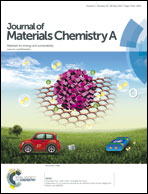Enhanced open-circuit voltage in polymer solar cells by dithieno[3,2-b:2′,3′-d]pyrrole N-acylation†
Abstract
A series of low bandgap copolymers composed of N-acyl-substituted dithieno[3,2-b:2′,3′-d]pyrroles (DTPs) as the electron rich donor constituents (with various alkyl side chain patterns) combined with different electron deficient acceptor building blocks are developed for polymer solar cell applications. Due to the introduction of the N-acyl substituents, the HOMO energy levels of the push–pull copolymers decrease as compared to the N-alkyl-DTP analogues, resulting in an increased open-circuit voltage (Voc) and hence solar cell performance. For an N-acyl-DTP-alt-thieno[3,4-c]pyrrole-4,6-dione (PDTP-TPD) copolymer a bulk heterojunction device with a Voc up to 0.80 V and a power conversion efficiency of 4.0% is obtained, the highest value for DTP-based polymer materials to date. Moreover, by implementation of a conjugated polyelectrolyte cathode interlayer the short-circuit current noticeably increases, enhancing the solar cell efficiency to 5.8%.
![Graphical abstract: Enhanced open-circuit voltage in polymer solar cells by dithieno[3,2-b:2′,3′-d]pyrrole N-acylation](/en/Image/Get?imageInfo.ImageType=GA&imageInfo.ImageIdentifier.ManuscriptID=C4TA00525B&imageInfo.ImageIdentifier.Year=2014)
- This article is part of the themed collection: 2014 Journal of Materials Chemistry A Hot Articles

 Please wait while we load your content...
Please wait while we load your content...